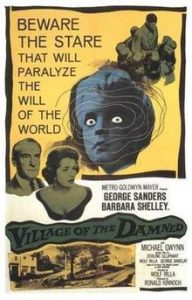Village of the Damned-1960
Director Wolf Rilla
Starring George Sanders, Barbara Shelley
Scott’s Review #701
Reviewed November 30, 2017
Grade: B
Village of the Damned is a 1960 black and white horror film, released during a spectacular year for the film genre- and specifically for the horror genre.
With legendary films such as Hitchcock’s Psycho and Michael Powell’s British Peeping Tom making their debuts at the same time, what a coincidence that Village of the Damned (also British) shares the same year.
The film is a satisfying treat- certainly not on par with the aforementioned duo of masterpieces, but on its terms is a fine film, with just enough suspense and intrigue to make it a memorable affair.
Anything in movie horror involving children is downright creepy, so German director Wolf Rilla is wise to adopt a film based on a 1957 novel entitled The Midwich Cuckoos, by John Wyndham.
The title is one that I simply adore and wish Rilla had kept for the film. Alas, he did not, but the story is well written and almost like a long episode of The Twilight Zone or a similar television chapter from the 1960s.- it just seems like more of an episodic experience.
No disrespect, of course, but the film simply does not contain the bombast expected from a feature film, but rather a compartmentalized, small tale.
In the sleepy little town of Midwich, England, a polarizing force suddenly, and without warning, overtakes the town, causing all of the inhabitants to fall unconscious and into a state of inactivity. Attempts by the military to enter the town fail, even as an airplane crashes to the ground after attempting to cross into Midwich.
As quickly as these events occur, the townspeople “wake up” and resume normalcy. When two months later all women of childbearing years suddenly become pregnant, gossip and intrigue ensue. As the years go by all of the children look similar, with platinum blonde hair, piercing eyes, and rapid growth spurts.
Furthermore, they all are telepathic and communicate with each other in this manner.
The central characters include a prominent professor, Gordon Zellaby (George Sanders), and his wife Anthea (Barbara Shelley), who are the parents of one of the children, named David, who appears to be the leader of the other children.
As the children become increasingly menacing and intelligent as they grow older, sometimes hurting or killing other townspeople by somehow “possessing” their thoughts, Gordon must race to find a way to trap and stop the children from more dastardly deeds.
The use of black and white cinematography and the small-town setting successfully give Village of the Damned an eerie and mysterious vibe, yet it is little or no bloodshed nor the traditional horror-themed elements- hence the above Twilight Zone reference.
The film does not need these to succeed as the psychological mystique is effective enough. We wonder to ourselves, “What is wrong with these kids?” and “Why do they act so strangely?” “Are they possessed?” and “Is this some kind of weird experiment?”
The answers are never really explained in detail.
Slight negatives to the film are the only limited character development among any of the prominent characters such as Gordon or Anthea, and in this way these roles are one-dimensional- the children are the stars of the show.
Sanders and Shelley are adequately cast, but I can think of numerous other actors who could have played these parts well or even better.
The conclusion to Village of the Damned is unspectacular and I was left with an unsatisfied feeling, especially as related to other more satisfying aspects of the film as a whole.
I felt like a bit of potential was not reached.
Gordon merely orchestrates a big event, thereby sacrificing himself to destroy the children, and the film ends.
Village of the Damned was followed by a 1963 sequel entitled, Children of the Damned, which was not deemed a critical nor a commercial success.
Years later, in 1995, the film was remade and directed by John Carpenter and was also met with poor reviews.
